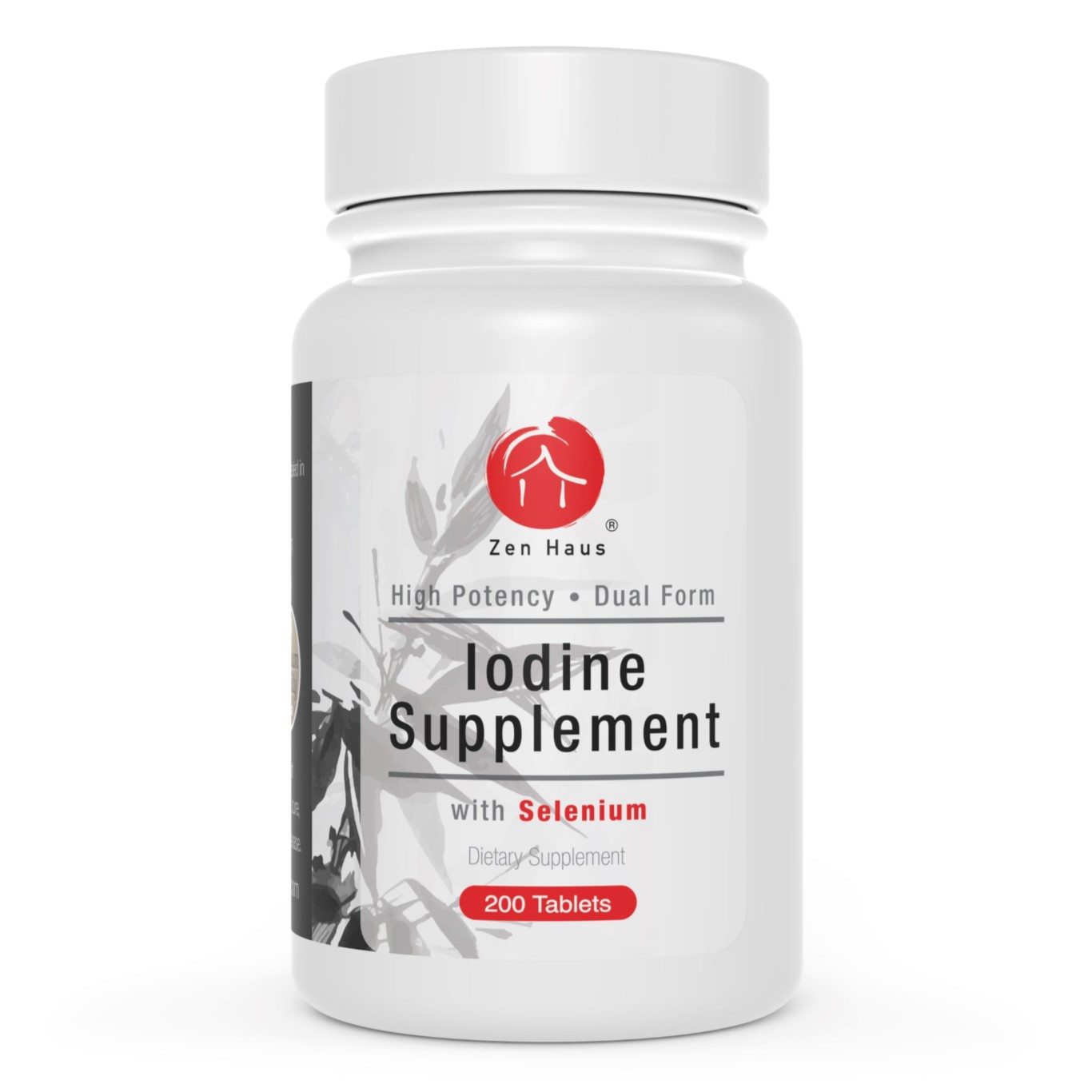Iodine and Iodides in Seaweeds and Supplements
The art of healing comes from nature and not from the physician.
Therefore, the physician must start from nature with an open mind.
-Paracelsus
This article focuses on iodine and seaweeds while building on ideas established in Iodine As Medicine and Why KI. It is not required to read them first but it will help to put the information we are presenting here in context.
The Iodine As Medicine article explained how the Japanese diet was the basis for determining an appropriate daily dose of iodine. The Japanese iodine intake from edible seaweeds is among the highest in the world with an average of 12-14 mg per day.1 This was confirmed as an appropriate dose by studies done to measure the thyroid’s retention of iodine at varying doses.2 Beyond 12-14 mg the body begins to excrete increasing amounts iodine, as iodide (I-), in the urine. The higher iodine intake has been linked to lower breast cancer mortality rates, less incidence of prostate cancer, and lower infant mortality rates in Japan. Here are some Japanese health statistics linked to high seaweed consumption:3
- Japanese average life expectancy (83 years) is five years longer than US average life expectancy (78 years) 4
- The 1999 age-adjusted breast cancer mortality rate was 3x times higher in the US than in Japan 5
- 10 years after arriving in the US (in 1991), breast cancer rates of immigrants from Japan increased from 0.2% to 0.3% 6
- The 2002 age-adjusted rate of prostate cancer in Japan was 12.6 per 100,000, while the US rate was almost 10x as high 7
- Heart related deaths in men/women aged 35-74 years are higher in US (1,415 per 100,000) than in Japan (897 per 100,000) 8
- In 2004, infant deaths were over twice as high in the US (6.8 per 1,000) as they were in Japan (2.8 per 1,000) 9
In the Why KI post we made clear arguments showing why potassium iodide (KI) is the best form of iodine for ingestion. In Part IV we discussed why Lugol’s iodine, a combination potassium iodide (KI) and molecular iodine (I2), is also effective.
There are many in the iodine-taking community that prefer to have molecular iodine included in their iodine supplement. Some claim that it helps maintain a healthy level of stomach bacteria. Some suggest that it is more effective in displacing excess (or toxic) halides stored in the body. These claims are difficult to prove. There is no knowledge of the mechanisms at play or how they work. These are testimonials and it is left as a matter of consumer preference. Since molecular iodine can be absorbed directly into the cell, as with trans-dermal applications, including it may also be helpful for individuals with damaged Sodium-Iodide Symporters. Especially for those who are new to supplementing with iodine. Those who wish to have molecular iodine included in their supplements should consider how much of it should be taken. A good question to ask then is what relative amounts of molecular iodine and iodide should be consumed in order to emulate the iodine gotten from edible seaweeds consumed in Japan? This article attempts to answer that question.
Sea vegetables contain both iodide and molecular iodine. The relative amounts of iodide and molecular iodine depend on the type of sea vegetable. We will examine the relative amounts of both forms of iodine in different sea vegetables. We want to determine an appropriate ratio of molecular iodine to iodide that reflects what is naturally occurring in the sea vegetables most often consumed in Japan. This ratio can inform the formula for an iodine supplement that includes molecular iodine.
Getting Into The Seaweeds
Three Types of Common Edible Seaweed
Edible seaweeds can be grouped into three different phylum: brown, green and red algae.
Brown Algae
Brown seaweeds are a key source of food for many aquatic animals. Humans also eat them and sometimes use it for medicine. It has traditionally been used for treating thyroid goitre. The link between iodine and thyroid hormones was established soon afterwards. Brown algae includes edible seaweeds such as Wakame, Kombu, Bladderwrack and Hijiki.
Green Algae
Green seaweeds tend to be single cellular. They grow mostly in freshwater and sub-aerial locations. Green algae includes edible seaweeds such as Chlorella and Sea Grapes or Green Caviar (Caulerpa Lentillifera).
Red Algae
Red seaweeds are mostly multi-cellular marine algae that reproduce sexually. Red algae includes popular edible seaweeds such as Nori and Irish Moss.
Popular Sea Vegetables in Japan
There are over 30 kinds of edible seaweeds. Our discussion will include the five most popular seaweeds in the Japanese diet.
Nori
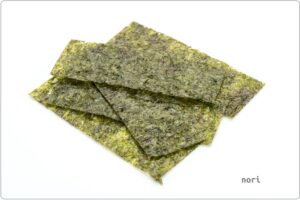 The genus most demanded by the Japanese diet is Nori. Though it looks green it belongs to the red algae phylum. Nori has been eaten in Japan since ancient times. It was originally consumed in a wet form as a paste. During the Edo period in the 1750’s the Japanese started processing nori paste using papermaking methods to produce the dry sheets we are familiar with today. Nowadays it is mostly consumed in its dried paper form.
The genus most demanded by the Japanese diet is Nori. Though it looks green it belongs to the red algae phylum. Nori has been eaten in Japan since ancient times. It was originally consumed in a wet form as a paste. During the Edo period in the 1750’s the Japanese started processing nori paste using papermaking methods to produce the dry sheets we are familiar with today. Nowadays it is mostly consumed in its dried paper form.
Seaweeds are known for having a high concentration of iodine. However, of all the edible seaweeds Nori has the lowest amount of iodine. It has much less iodine than Wakame and Kombu.10
Wakame
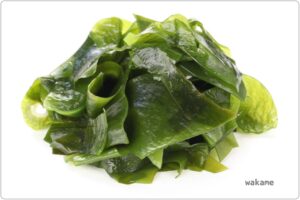 The second most demanded genus is Wakame. Though it has a bright green color it belongs to the brown algae phylum and is classified as a kelp. It is harvested by hanging collector strings in the water where Wakame spores attach and grow upon. Wakame is often dried for preservation and re-hydrated for cooking. It is appreciated for being tender and succulent. In the west it is best known for being a tasty addition to miso soup. Wakame is also served on its own or with root vegetables or fish and also in salads.
The second most demanded genus is Wakame. Though it has a bright green color it belongs to the brown algae phylum and is classified as a kelp. It is harvested by hanging collector strings in the water where Wakame spores attach and grow upon. Wakame is often dried for preservation and re-hydrated for cooking. It is appreciated for being tender and succulent. In the west it is best known for being a tasty addition to miso soup. Wakame is also served on its own or with root vegetables or fish and also in salads.
Wakame comes in second when it comes to iodine content. It has much less iodine than Kombu and tends to have two to four times the iodine content of Nori.
Kombu
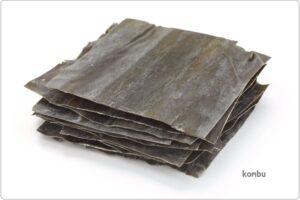 The third most demanded genus is Kombu. It belongs to the brown algae phylum and is classified as a kelp. It grows in long strips and is extensively cultivated on ropes in the seas of Japan and Korea. Kombu has a chewy or gelatinous texture and is considered very delicious. It is widely eaten in East Asia and is one of the main ingredients in Japan for making soup stock (dashi). It is used to flavor other dishes as well, especially sushi rice. Kombu is also chopped into fine strips and made into a flavourful chilled side dish (tsukudani).
The third most demanded genus is Kombu. It belongs to the brown algae phylum and is classified as a kelp. It grows in long strips and is extensively cultivated on ropes in the seas of Japan and Korea. Kombu has a chewy or gelatinous texture and is considered very delicious. It is widely eaten in East Asia and is one of the main ingredients in Japan for making soup stock (dashi). It is used to flavor other dishes as well, especially sushi rice. Kombu is also chopped into fine strips and made into a flavourful chilled side dish (tsukudani).
Kombu has very high iodine content among seaweeds. It contains substantially more iodine content than Nori and Wakame.11
Nori, Wakame and Kombu make up virtually all of the seaweed consumed in Japan. Other brown seaweeds, such as Bladderwrack and Hijiki, are also commonly used but to a much lesser extent.
Analysis
Ratio of Molecular Iodine to Iodides in Green, Brown and Red Algae
We want to have an estimate of the molecular iodine (I2) to iodide (I-) ratio that the Japanese consume by eating seaweed. We will consider what kinds of seaweeds the Japanese are eating and how much of each kind is eaten. We will also consider the molecular iodine to iodide ratio attributed to each phyla. After putting this information together we will provide an estimate of the average molecular iodine to iodide ratio for consumed seaweeds in Japan.
The Most Consumed Seaweeds in Japan
Nori is the most consumed edible seaweed in Japan. It accounts for 45% of seaweed consumption.12 The second most consumed seaweed is Wakame which accounts for 30% of seaweed consumption.13 These two seaweeds alone make up 75% of the seaweed consumed. Most of the remaining 25% is attributed to brown seaweeds like Kombu, Bladderwrack and Hijiki. Attributing the remaining 25% to brown algae is a reasonable estimate then.
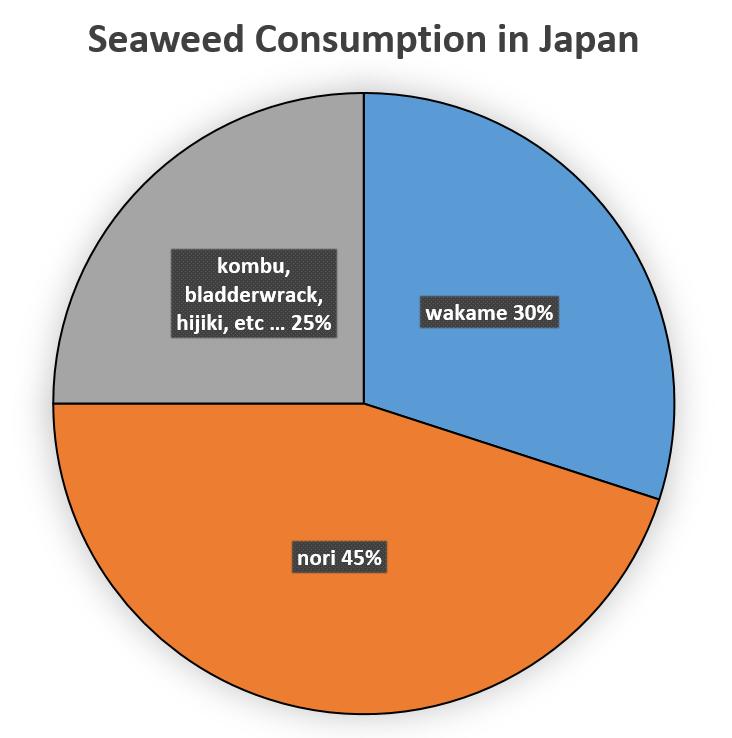
Iodine Content Of The Most Consumed Seaweeds
We reference two sources for the iodine content of seaweeds. The first is a study done using samples from multiple Asian countries.14 In this study, samples were taken from Japan, China, Taiwan, Korea and Thailand. The second source is a study done using samples only from Japan.15 The table below compares the results of both studies and show that the relative amounts of iodine in seaweeds are consistent.
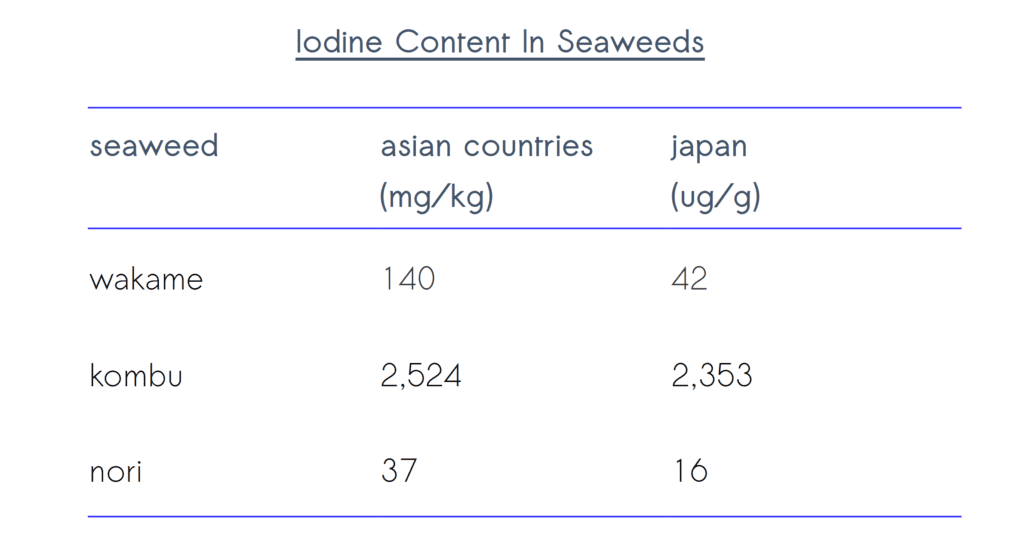
In both studies it is clear that Kombu has a much higher concentration of iodine than Wakame and Nori, and Nori as the lowest concentration of iodine. These factors come into play when we use this information to assign weights to the molecular iodine to iodide ratios of different seaweeds. Since we are interested in the iodine intake from the Japanese diet we will use the data from the Japanese study in our analysis.
Molecular Iodine to Iodide Ratios for Brown, Green and Red Algae
Researchers from the department of Analytical Chemistry, Nutrition and Bromatology at the University of Santiago de Compostela in Spain developed a method to determine total molecular iodine to iodide inedible seaweeds. In 2007, they published results from harvested seaweed on the Galician coast in Northwest Spain. Their analysis showed that “most of the iodine is present as iodide in brown seaweed samples (90% of the total iodine), while red seaweeds have iodide percentages lower than 30% and green seaweeds lower than 80%.”16 This translates into molecular iodine to iodide ratios of 11%, 233%, and 25% for brown, red and green seaweeds respectively.
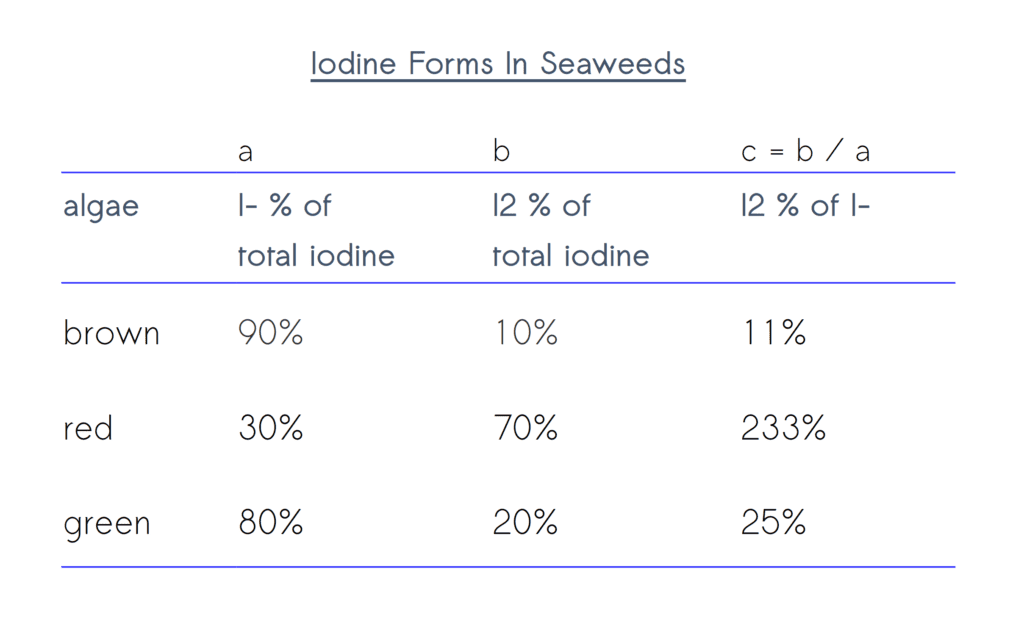
Estimate the Average Molecular Iodine to Iodide Ratio of Seaweed Consumed in Japan
Now lets combine the information about the most consumed seaweeds, the iodine content of these seaweeds and ratio of iodine forms to estimate the molecular iodine to iodide ratio of iodine taken up by seaweed consumption in Japan.
| A | B | C | D | E | ||
| Seaweed | Phylum | Consumption | Iodine Content | A x B | Weights (C as %) | I2 to I- Ratios |
| Wakame | Brown | 30% | 42 | 12.60 | 2.07% | 11% |
| Kombu | Brown | 25% | 2,353 | 588.25 | 96.74% | 11% |
| Nori | Red | 45% | 16 | 7.20 | 1.18% | 233% |
| Total/Average | 100% | 100% | 14% (weighted by D) |
.
Working from left to right the relative consumption amounts (A) are used as weights for the iodine concentration amounts (B). Multiplying these figures gives a relative amount of iodine concentration consumed (C). In order to use these amounts as weights for the ratios we represent them as percentages that sum to 100% (D). These are estimates for the relative amounts of iodine ingested from the different seaweeds. We can see that Kombu is heavily weighted at 97%. The brown seaweeds account for 99% of the iodine intake. When we multiply these percentages by the ratios (weighting the ratios) we arrive at a weighted average molecular iodine to iodide ratio from seaweed consumed in Japan that is 14%.
In short, the Japanese consume mostly brown seaweeds with the exception of nori which is a red seaweed. About 99% of the iodine ingested comes from brown seaweeds which have an molecular iodine to iodide ratio of 11%. The high molecular iodine to iodide ratio of 233% in red seaweeds brings the average up to 14%.
Lugol’s Iodine and The Zen Haus Iodine Supplement
Now lets compare our estimated ratio of molecular iodine to iodide from seaweed in the Japanese diet to Lugol’s iodine and the Zen Haus Iodine Supplement.
| A | B | C = B / A | ||
| I- (mg) | I2 (mg) | I2 % of I- | Times Greater Than Japanese Diet | |
|
Japanese Diet Estimate
|
14% | |||
| Zen Haus Iodine | 12.7 | 3 | 24% | 1.7 |
| Lugol’s Iodine | 7.5 | 5 | 67% | 4.8 |
.
Here we can see that both Zen Haus Iodine and Lugol’s Iodine have a relatively higher amount of molecular iodine compared to the Japanese diet. The Zen Haus Iodine ratio is 1.7x higher and the Lugol’s iodine tablets ratio is 4.8x higher.
We suggest that Lugol’s Iodine ratio is too high and this is why some people have digestive issues when taking them. As we pointed out in Why KI – Part II, studies have indicated that the presence of molecular iodine increases the risk of iodism and negative side effects. By extension we may presume that greater amounts of molecular iodine will increase these risks and negative side effects. As noted in Why KI – Part I, the Lugol’s solution was formulated to maximize the amount of molecular iodine in a stable solution to be used as a potent antiseptic and disinfectant in the early 1800s. The Lugol’s Iodine solution was not formulated for supplementation.
The Zen Haus Iodine Supplement molecular iodine to iodide ratio is higher than what we estimated from the Japanese diet. Though it is much lower than Lugol’s Iodine solution and is thus the safer alternative. We designed our dual form iodine supplement to address the needs of those who want to use iodine supplements to help control stomach bacteria and perhaps help displace toxic halides in the detox phase. Controlling stomach bacteria and displacing toxic halides go beyond the basic need of supplementing with iodine. Our exposure to high amounts of halides is a modern issue and this justifies some departure from what the traditional Japanese diet informs us about iodine intake. Since molecular iodine can be absorbed right into the cell, as with transdermal applications, including it may also be helpful for individuals with damaged Sodium-Iodide Symporters when beginning to supplement with iodine for the first time.
The Lugol’s Iodine solution was not formulated for supplementation.
Summary
We can only speculate on the additional benefits of molecular iodine in iodine supplements. There is not enough research to support claims of molecular iodine controlling stomach bacteria and more effectively displacing toxic halides. However it is clear that some individuals prefer taking molecular iodine. The dual form iodine supplement, which includes molecular iodine, is a safe alternative to Lugol’s Iodine. Moreover, the Zen Haus formulation more closely represents the Japanese iodine intake from seaweeds. If you want take molecular iodine safely while still gaining the benefits, we suggest you move with the large crowd of Japanese seaweed eaters over the centuries and use a product that has a balance of iodine and iodide comparable to the seaweeds consumed.
.

